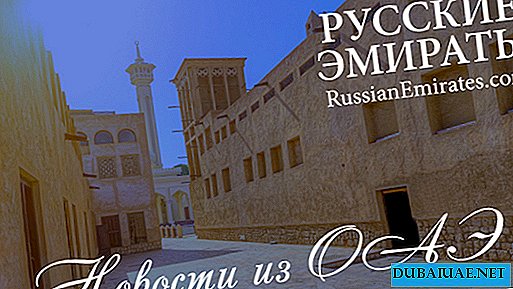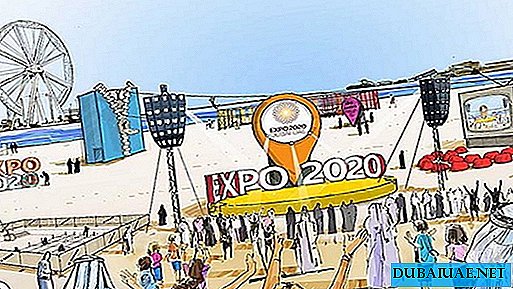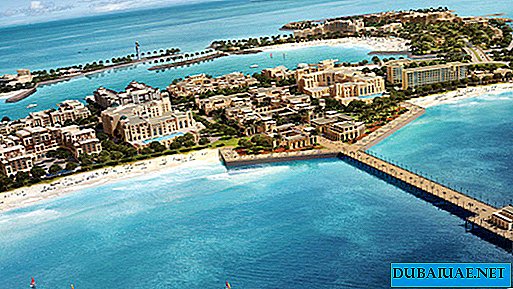 Almost all residents and many guests of Dubai are well aware of the Ibn Batuta Mall, a recently opened large and relatively few-crowded shopping center, located on the outskirts of the city in the direction of the capital of the UAE. 6 thematic building pavilions give a special originality to this shopping center, of which this center actually consists of: these are Indian, Chinese, Persian, Tunisian, Egyptian and Andalusian (Spanish) pavilions.
Almost all residents and many guests of Dubai are well aware of the Ibn Batuta Mall, a recently opened large and relatively few-crowded shopping center, located on the outskirts of the city in the direction of the capital of the UAE. 6 thematic building pavilions give a special originality to this shopping center, of which this center actually consists of: these are Indian, Chinese, Persian, Tunisian, Egyptian and Andalusian (Spanish) pavilions.
A visitor who first arrives at the Ibn Batuta Mall soon learns that the name of the shopping center is due to the famous medieval Arab traveler Ibn Batuta, who in the 14th century visited countries that named the pavilions-buildings of the shopping center (and not only these countries )
Who is Ibn Batut, what is known about him and what kind of journey did he make? As we soon learn, this journey was more than impressive, even by today's standards - for twenty-nine years Ibn Batuta covered a distance of 117,000 kilometers, having traveled to North and West Africa, Southern and Southeast Europe (including in today's Russia and Ukraine), the Middle East, India and China, Sumatra, Ceylon and the Maldives, while visiting many countries and getting married, no less, 10 times! Given that this journey significantly exceeds the range of the trip of the famous predecessor of Ibn Batuta - the Italian Marco Polo, it becomes clear why many Arab, and not only Arab sources, call Ibn Batutu the greatest traveler of the Middle Ages.
But let's start in order. So, Abu Abdullah Muhammad Ibn Batuta was born in the city of Tangier (Morocco) on February 24, 1304. His family came from the Berber tribe Lavita.
Very little is known about the first years of his life, his youth. Almost everything that we know about the life of Ibn Trampoline is known from himself. Returning from his last journey, he dictated the story of his travels to his friend, a scientist by the name of Ibn Juzai. A few years later, in 1356, Ibn Juzai published a book that contained the story of Ibn Batuta and many comments of Ibn Juzai himself. This book, titled in the oriental flowery style, "A priceless gift for those who reflect on the wonders of cities and travels," is the main source of information about Ibn Batut and his fantastic wanderings. Later, the book was simply called "Rila", which in Arabic means "Travel".
From the pages of the book we see the image of a brave navigator and traveler, dozens, if not hundreds of times of looking in the face of death, a smart, insightful, highly educated and erudite person, the friendship with which was sought by many "powerful people" of kings and sultans, emperors and khans; a person deeply religious and at the same time loving life in all its manifestations ... From the book we know that in his youth Ibn Batuta studied the foundations of the natural sciences, as well as Muslim law - Sharia. The saying attributed to the Prophet Muhammad is known: "Seek knowledge, even if this search leads you to China." It is possible that it was this saying that prompted the young Moroccan to his first trip - the hajj to Mecca, which he made at the age of 21. In "Travels" it is said about this: "I gathered my courage and left my beloved family, just like a bird leaves its nest." Thus began the journey of 29 years.
From his native Tangier, Ibn Batut goes to Cairo, and from there to Damascus. After spending Ramadan in Damascus, the traveler joins the caravan moving to Medina - the city where the Prophet Muhammad is buried. From there, Ibn Batuta performs his first hajj to Mecca, where he performs all the rituals laid out by a Muslim pilgrim. From Mecca, he intended to return home, but then changed his mind and went to Iraq and Iran.
In Iraq, Ibn Batuta visits the holy city of AlNajaf - the birthplace of the fourth caliph Ali. From there he heads to Basra, then to Isfahan; in just a few decades, this city will be destroyed by the hordes of Tamerlane. After that were Shiraz and Baghdad. From there, Ibn Batuta along the Silk Road moves north to Tabriz, a major shopping center of the time.
Having completed this journey, Ibn Batuta returns to Mecca and lives in this city for about a year. Then he decides to go on another journey, this time, to the Red Sea and along the coast of West Africa. On this path, his first main goal was Aden, where he was going to engage in trade. But before that, Ibn Batuta decided to take the last voyage - as he then believed and hired on a ship sailing south along the African coast. The main stops at the ship were Mogadishu, Mombasa, Zanzibar and Kilwa. However, soon the direction of the strong monsoon winds changed, and the ship, and with it Ibn Batuta, returned to Saudi Arabia. From here he heads to Oman and to the shores of the Strait of Hormuz.
Then Ibn Batuta again spends in Mecca for about a year, after which he decides to join the sultan of Delhi (India). To get to India, which at that time was a very difficult enterprise, Ibn Batuta decides to first arrive in Anatolia, which was then under the rule of the Seljuk Turks, and there join one of the caravans going to India.
 Soon the traveler sets sail from Damascus on a Genoese ship to the southern coast of modern Turkey and, after some adventures, gets to the city of Sinop - a large shopping center on the Black Sea. After spending more than a month in Sinop, Ibn Batuta decides to cross the Black Sea and visit the lands subject to the Golden Horde - the Crimea and the Volga region.
Soon the traveler sets sail from Damascus on a Genoese ship to the southern coast of modern Turkey and, after some adventures, gets to the city of Sinop - a large shopping center on the Black Sea. After spending more than a month in Sinop, Ibn Batuta decides to cross the Black Sea and visit the lands subject to the Golden Horde - the Crimea and the Volga region.
It seems that readers will be interested to learn more about this part of the wanderings of our hero, therefore the story of Ibn Trampoline from the book "Travels" is further reproduced.
"... We hired a ship from the Greeks, set sail and headed for the city of Karsh (Kerch). The city is located in the steppe, green and flowering, but flat and treeless. There is no firewood, so the Tatars drown dung .... The only way to travel in this desert "These are wagons. The day after our arrival, one of the merchants who were in our company hired several wagons from the Kipchaks (Polovtsy), and we moved to Kafu (modern Theodosia - approx. Auth.) - a large city located on the coast the sea, inhabited by Christians, mainly Genoese; their ruler vut Demetrius ...
... We hired a wagon and went to the city of Kirim (the first capital of the Crimean Khanate, today the city of Old Crimea - approx. Auth.), Which lies on the lands of the Sultan of Uzbeg Khan. ... The Tatar wagons have four large wheels, a light tent from thin boards; there are windows with bars on the sides. During the ride you can sleep, eat, read or write in the wagon ...
... At every stop, the Tatars let their horses, bulls and camels graze in the steppe, without shepherds and guards. They do not need this, because they have very strict laws against theft. The person who will find the stolen horse is obliged to return it, giving in addition nine of his horses. If he is not able to do this, sons are taken from him. And if he does not have sons, they slaughter him like a sheep ... Tatars do not eat bread or any solid food; they cook soup from cereal, similar to millet, with pieces of any meat that comes into their hands. They also drink mare's milk, which they call "koumiss." From the same cereals they prepare a light alcoholic drink called "buza", which, they say, is not forbidden to drink ...
In this country there are a lot of horses that are very cheap. A good horse costs no more than one dinar for our money. The entire existence of the Tatars depends on horses. One Tatar may have a thousand or more goals. They even sell them to India, in herds of six hundred heads or so ...
From Azov I headed to the city of Majar, following along with the emir Tuluktumur. Majar is one of the large Tatar cities; it is located on the banks of a large river (the ruins of this once prosperous and subsequently destroyed city are located on the banks of the Kama River, not far from present-day Georgievsk (Stavropol Territory of the Russian Federation - author's note).
From Majar we went to the camp of the Uzbek Sultan, which is a four-day drive, at the foot of Mount Beshtau. In these mountains there is a hot stream in which the Tatars bathe, believing that this protects them from disease.
On the way to Beshtau, we caught up with a whole city in motion, which moved with its inhabitants, mosques and bazaars, housed in carts that pulled horses; columns of smoke rose from the camp kitchens (since the Tatars often cook on the march). When we reached the camp, the Tatars removed the tents from their tents and set them on the ground like tents; they did the same with mosques and bazaars ...
From there we went to the city of Bulgar (or Bolgar; the ruins of this city are on the left bank of the Volga, not far from the confluence of the Kama River. In the 10-15 centuries this city was the capital of the medieval state of Volga-Kama Bulgaria, captured by the Mongol-Tatars in the 13th century In the time of Ibn Tututa, the city of Bulgar was a large trading center, however, it is difficult to understand how our hero managed to get from Majar to Bulgar in 10 days - this is about 1,500 kilometers! Note Auth.
I returned from Bulgar with the emir, whom the Sultan sent to accompany me; soon we arrived in the city of Hajj Tarkhan (today's Astrakhan - approx. Auth.). It is a beautiful city with many large bazaars; he stands on the huge Itil River (Volga). In winter, this river freezes, and people ride on ice in a sleigh ...
... Arriving in Astrakhan, we found that the Sultan had already left there and was in the capital of his state .... On the fourth day of the journey, we reached the capital city of Saray (in those days there were two cities called "Saray", which were alternately the capital of the Golden Horde khans : “Old Saray”, located near the current village of Selitrennoye, 150 km north of Astrakhan, and “New Saray”, located in the modern city of Tsarev, about 400 km north of Astrakhan. Sultan Muhammad Uzbeg transferred the capital from Old to New Saray for n How many years before the journey of Ibn Battuta. Apparently, it is the narrative of the New Saray, the ruins of which remain today. Approx. Ed.).
... The barn is a very beautiful, large and densely populated city. One morning we decided to drive the whole city from end to end; we left the outskirts of the city early in the morning and reached the opposite outskirts of the afternoon. The population of the city is quite colorful; Mongols, Tatars, Ossetians live here - they are all Muslims, as well as Circassians, Russians and Greeks - all Christians. Each of these peoples lives in its own separate quarter. Merchants and traders from Iraq, Egypt, Syria and other countries live in a separate walled quarter to protect their goods ...
... On these same days, one of the wives of the Sultan of India went on a trip to her hometown - the capital of the Byzantine Empire, Constantinople - to give birth to another child there. Upon learning of this, Ibn Batuta persuaded the Sultan to be included, in modern language, in the "group of accompanying persons." This was his first trip outside the Islamic world (the Turks would capture Constantinople in 1453, 120 years after the events described).
 Arriving in Constantinople at the end of 1332, Ibn Batuta met with the Byzantine Emperor Andronicus III Paleologist, examined the famous St. Sophia Cathedral. After spending about a month in Constantinople, he again returns to Astrakhan, and then goes, along the shores of the Caspian and Aral Seas, to Bukhara and Samarkand. From here, he moves south to Afghanistan and then makes a difficult and dangerous transition, through the snowy mountain passes, to the cherished goal of his long journey - India.
Arriving in Constantinople at the end of 1332, Ibn Batuta met with the Byzantine Emperor Andronicus III Paleologist, examined the famous St. Sophia Cathedral. After spending about a month in Constantinople, he again returns to Astrakhan, and then goes, along the shores of the Caspian and Aral Seas, to Bukhara and Samarkand. From here, he moves south to Afghanistan and then makes a difficult and dangerous transition, through the snowy mountain passes, to the cherished goal of his long journey - India.
There he enters the service of Sultan Mohammed Tuglak, the ruler of the so-called Delhi Sultanate. It was a Muslim state, which, during its heyday in 1315 (that is, 20 years before the arrival of Ibn Batuta there) occupied the territory of almost the entire Indian subcontinent. At the end of the 14th century, it fell under the onslaught of the hordes of Timur (Tamerlane).
In order to strengthen his rule, Sultan Mohammed sought to attract as many Muslim scholars, theologians, as well as officials to his country. Given his education, Ibn Batuta became a “qadi" (that is, a judge) at the court of this ruler. I must say that Sultan Mohammed Tuglak, even by the standards of that turbulent time, was an extremely extravagant and psychopathic person. It’s enough to mention that he became a ruler by killing his father. According to Ibn Batuta, Sultan Mohammed "more than anything else loved to give gifts and shed blood." It is not surprising that the position of Ibn Trampoline at the court of such a ruler was extremely unstable and changeable; today he was a favorite of the Sultan, and tomorrow was under suspicion of plotting against the government. In the end, Ibn Batuta decides to leave such an unreliable patron, under the pretext of having to perform another hajj, but the Sultan unexpectedly offers him the post of his ambassador to China. Our hero willingly accepts this proposal, as it promises him new wanderings, especially at the expense of the Sultan.
On the way to the coast, Indians attacked Ibn Batutu and his companions; he was robbed and nearly killed. Nevertheless, he manages to get to Calcutta and get on a ship going to China through the Maldives. He spends 9 months on these islands - much more than he originally planned. The fact is that the ruler there was in dire need of “qualified personnel”, as we would say today, and the experienced lawyer Ibn Batutu was kept there forcibly. He was even forced to marry one of the daughters of the ruler. With great difficulty, our hero manages to leave the inhospitable islands and get to the island of Ceylon.
On the way from Ceylon to China, the ship on which Ibn Batut sailed falls into a storm; another ship rescues him and the whole team, but they are soon attacked by pirates. With great difficulty, he manages to reach China. He visits Chittagong, Sumatra, Vietnam, Gwangju (South China). From there, he travels north and reaches Beijing.
Here, realizing that the goal of his life has been fulfilled, Ibn Batuta decides to finally return home. Through Calcutta and the Strait of Hormuz, he reaches Syria. Here he is informed that his father died a few years ago. In the life of Ibn Batuta, a "black streak" sets in, almost in the literal sense of the word, since at that time in the Middle East, as well as in Europe, a terrible epidemic of plague erupted, which in the Middle Ages was called "black death." The epidemic covers Syria, Palestine and the Arabian Peninsula. Nevertheless, he manages to escape the plague, and 25 years after his departure, Ibn Batuta gets to his native Tangier. Here he learns that his mother died of the plague just a few months ago ...
... Without catching any of the parents alive, Ibn Batut spends in his hometown for only a few days. From here he decides to go on a new journey - to Andalusia, the Muslim part of Spain. At this time, the Castilian king Alfonso XI threatened to seize Gibraltar, and Ibn Batuta joined the detachment of Muslims who decided to defend this city. However, by the time the detachment reached Gibraltar, the warlike king had died of the plague; Thus, fortunately, the need to fight disappeared, and Ibn Batuta decides to visit Spain just like that, for pleasure. He visits Valencia and Granada.
From there he returns home to Tangier, but again not for long.He goes on a new journey - to Africa, to the Islamic state of Mali, located on the edge of the Sahara desert. Probably, his decision was due to the fact that shortly before the events described, the Malian king Mansa Musa visited Cairo and made a sensation there with his unheard of wealth, a huge amount of gold and precious stones.
So, in the autumn of 1351, Ibn Batuta sets off again with one of the caravans, accompanied by his two cousins, Ibn Ziri and Ibn Adi. After a month of hard travel, the caravan gets to the city of Tagaz in central Sahara. It was a large shopping center, with gold mines. The caravan remained in Tagaz for several weeks, since it was necessary to find a local guide - "taksif", who would lead the caravan through the desert. It was a very difficult task; if, on the way, the takshif was lost for some reason, the caravan would have been waiting for almost inevitable death.
Nevertheless, they could not escape the path of misfortune: a quarrel broke out between two cousins of Ibn Batuta, after which Ibn Ziri lagged behind the caravan and was lost; no one had ever seen him again ... In the end, having overcome almost 500 difficult miles, the caravan reached the border of the state of Mali. From here, the path continued along the Niger River; finally, travelers arrived in the capital of the empire, the city of Timbuktu.
After spending 8 months in Mali, Ibn Batuta returned home to Morocco - this time for good; here he, among other things, dictated his Travels.
Little is known about the last years of his life. It is believed that he worked as a judge for several years. Ibn Batuta died between 1368 and 1377 (the exact year of death is unknown), from the same disease that claimed his mother’s life - from the plague. For several centuries, his book was little known, even in the Muslim world, but in the 19th century it was rediscovered and translated into several European languages.
Today the name of Ibn Trampoline is widely known - in addition to the already mentioned shopping center in Dubai, the name of this outstanding Arab traveler and writer is one of the lunar craters.











